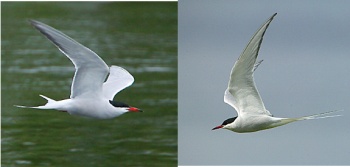m |
(Similar Species. Picture & text by Steve G) |
||
| Line 6: | Line 6: | ||
'''Non-breeding adult and immature''': Forehead white, crown streaked black and white, nape black. The bill is black and the legs and feet dark red to blackish. | '''Non-breeding adult and immature''': Forehead white, crown streaked black and white, nape black. The bill is black and the legs and feet dark red to blackish. | ||
====Similar Species==== | ====Similar Species==== | ||
| − | + | [[Image:4381Commic-terns.jpg|thumb|350px|right|Common tern is on the left, Arctic on the right<br />Photo by {{user|Steve+G|Steve G}} ]] | |
| − | [[Image: | + | [[Common Tern|Common]] and Arctic Terns are a species pair easily confused. <br /> |
| + | On the ground the short legs of Arctic terns give them a somewhat huddled look whilst the tail feathers in summer birds extends well beyond the folded wings. Common stand taller and the tail feathers don't extend past the primaries. <br /> | ||
| + | On flying birds the wing of Arctic when seen against the light is really quite translucent whereas in Common only the inner primaries are translucent. Common Terns have a black wedge or notch effect on the upper outer 5/6 primaries which is absent in Arctic and the trailing black edge of the primaries is narrower and neater in Arctic. <br /> | ||
| + | I find the easiest way to separate them in Summer is by the fact that Arctics have a very buoyant bouncy flight and are more compact in the head and neck coupled with the long tail giving the impression that the wings are well-forward on the body whereas Common Terns seem to have their wings more to the centre of the bird. The real clincher however is the beak - Common Tern has a fairly long somewhat decurved orange-red beak with a clear black tip whilst Arctic terns have a shorter solid blood-red beak (and are more likely to draw blood when you invade the nesting colony!!) | ||
| + | ''Written by Steve G'' | ||
==Distribution== | ==Distribution== | ||
Breeds in arctic and sub-arctic [[Europe]], [[Asia]], and [[North America]]. Migrates to the Antarctic for another summer. Accidental in [[Kansas]]. | Breeds in arctic and sub-arctic [[Europe]], [[Asia]], and [[North America]]. Migrates to the Antarctic for another summer. Accidental in [[Kansas]]. | ||
==Taxonomy== | ==Taxonomy== | ||
This is a monotypic species. <sup>[[#References|[3]]]</sup> | This is a monotypic species. <sup>[[#References|[3]]]</sup> | ||
| + | [[Image:Arctictern.jpg|thumb|350px|right|Immature Arctic Tern <br />Photo by {{user|jtwood|jtwood}}<br />Location: [[Shetland Islands]]]] | ||
==Habitat== | ==Habitat== | ||
Oceans. Nests on islands in the Arctic. | Oceans. Nests on islands in the Arctic. | ||
Revision as of 19:25, 27 June 2009
- Sterna paradisaea
Identification
Length 33–39 cm, mass 76-116 g.
Breeding adult: Black forehead, nape and crown and white cheeks; the mantle, back and upper wings are grey and the collar, rump and underwing are white. The deeply forked tail is white with grey outer webs. The long bill, legs and feet are red.
Non-breeding adult and immature: Forehead white, crown streaked black and white, nape black. The bill is black and the legs and feet dark red to blackish.
Similar Species
Common and Arctic Terns are a species pair easily confused.
On the ground the short legs of Arctic terns give them a somewhat huddled look whilst the tail feathers in summer birds extends well beyond the folded wings. Common stand taller and the tail feathers don't extend past the primaries.
On flying birds the wing of Arctic when seen against the light is really quite translucent whereas in Common only the inner primaries are translucent. Common Terns have a black wedge or notch effect on the upper outer 5/6 primaries which is absent in Arctic and the trailing black edge of the primaries is narrower and neater in Arctic.
I find the easiest way to separate them in Summer is by the fact that Arctics have a very buoyant bouncy flight and are more compact in the head and neck coupled with the long tail giving the impression that the wings are well-forward on the body whereas Common Terns seem to have their wings more to the centre of the bird. The real clincher however is the beak - Common Tern has a fairly long somewhat decurved orange-red beak with a clear black tip whilst Arctic terns have a shorter solid blood-red beak (and are more likely to draw blood when you invade the nesting colony!!)
Written by Steve G
Distribution
Breeds in arctic and sub-arctic Europe, Asia, and North America. Migrates to the Antarctic for another summer. Accidental in Kansas.
Taxonomy
This is a monotypic species. [3]
Habitat
Oceans. Nests on islands in the Arctic.
Behaviour
Diet
The diet includes fish and small marine invertebrates.
Breeding
The nest is a depression in the ground and 1-3 mottled eggs are laid. Both parents incubate the eggs for 27 days; the young fledge after 21–24 days.
Vocalisation
<flashmp3>Sterna paradisaea (song).mp3</flashmp3>
Listen in an external program
References
- Hockey, PAR, WRJ Dean, and PG Ryan, eds. 2005. Roberts' Birds of Southern Africa. 7th ed. Cape Town: John Voelcker Bird Book Fund. ISBN 978-0620340533
- Wikipedia. 2008. Arctic Tern downloaded 25 December 2008.
- Clements, JF. 2008. The Clements Checklist of Birds of the World. 6th ed., with updates to December 2008. Ithaca: Cornell Univ. Press. ISBN 978-0801445019.
Recommended Citation
- BirdForum Opus contributors. (2024) Arctic Tern. In: BirdForum, the forum for wild birds and birding. Retrieved 19 April 2024 from https://www.birdforum.net/opus/Arctic_Tern






